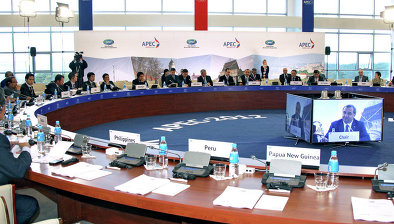By
Anant Mishra
The Asia-Pacific region makes up about half of the world’s surface area and approximately 40% of the planet’s population. It has been recorded to experience over 70 percent of the world’s natural disasters.
Studies and research indicate that the frequency and intensity of natural disasters in the region will increase in the coming years, exacerbated by unplanned urbanisation, poor land-use management, and climate change.
APEC’s human security agenda is focused on disaster management and emergency response, along with counter terrorism and pandemics. Disasters that affect one member economy can have significant spill-over effects in other economies.
In 2005, APEC Senior Officials first established the APEC’s Task Force for Emergency Preparedness (TFEP). Originally called the Virtual Task Force for Emergency Preparedness, the TFEP carried out much of its work via electronic communications. This task force was later given a formal mandate and official status. Pursuant to its Terms of Reference, the Task Force is mandated to coordinate and facilitate emergency and disaster preparedness within the APEC region.
In 2009, the importance of enhancing human security and reducing the threat of disruptions to business and trade in the Asia-Pacific region was re-emphasized by APEC Leaders. They recognized the importance of its work, and in 2010, the TFEP was awarded with a working group status, Emergency Preparedness Working Group (EPWG), within the APEC organisational framework.
Now the EPWG continues to play a constructive role in enabling the region to better prepare for, and respond to emergencies and disasters by helping to reduce the risk of disasters and building business and community resilience. By sharing expertise and collaborating on emergency preparedness issues, APEC members strengthen their capacity to mitigate emergencies and disasters.
The need for Emergency Preparedness measures
In the last few years, the world has witnessed an alarming number of disasters, both natural and artificially induced. From hurricane Katrina to hurricane Phailin, earthquakes in South-east Asia, typhoons in the Pacific, nuclear melt-downs in Fukushima, tsunamis, sink-holes and dam failures to name just a few.
Catastrophes in the Asia-Pacific region, such as the 2004 Indian Ocean Tsunami, the 2008 earthquake in China’s Sichuan province, the 2010 earthquake in Chile, and the 2011 earthquakes in New Zealand and Japan, are critical reminders of the importance and relevance of APEC’s emergency preparedness work.
Each of these disasters caused tremendous destruction, as well as loss of life to the order of hundreds of thousands. Property losses also entailed, not to mention those who survived, albeit with their lives torn apart, due to no fault of their own.
It is in the wake of these disasters, that a holistic and fail-proof contingency plan needs to be drafted and put into practice. Each country takes its own measures for emergency response, although from past instances, it is evident that some of these disasters are so enormous that it is beyond the capabilities of just a handful of nations to manage such events. This is why the global community as a whole needs to assess the risks posed by the forces of nature, as well as “man-made installations containing dangerous forces” (as defined by International Humanitarian Law). Plans must be drafted, involving the technology and resource pool of all nations of the APEC combined. After all, the difference between reactionary measures and precautionary measures could well be thousand saved lives.
APEC Growth Strategy
The APEC Growth Strategy highlights that disaster – along with disease, terrorism, and corruption – impact on the region’s economic and physical well-being by reducing economic productivity, and by disrupting commerce and trade. The Strategy identifies that APEC will help economies to better understand disasters’ economic and social costs; identify gaps in disaster risk reduction approaches in the region; and develop practical mechanisms to maximize business and community resilience. The strategy also states that Senior Officials should ‘foster enhanced cooperation and coordination within APEC to reduce threats and disruptions to business and trade’ and that ‘APEC should continue to collaborate with industry, academia, and international organizations to enhance preparedness against emergencies, natural disasters, and pandemics through public-private partnerships and networking among experts.’
The salient features of the detailed Growth Plan suggest that there is a need to synergise all aspects of disaster management together. The socio-economic repercussions of any type of disaster, and its area-of-impact are the two main factors when dealing with emergencies on a response-based stratagem. In case of preparedness, scientific information and past trends, should be analysed and studied upon, in collaboration with academia and experts in corresponding fields. So that a watertight plan to deal with and mitigate any kind of disaster fall-out is in place. All this, of course, is speaking from a purely idealistic perspective, and should be the ultimate aim of any committee or working group, functioning on a mandate such as the EPWG.



No Comments Yet!
You can be first to comment this post!